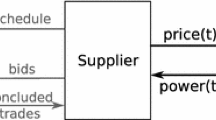Abstract
This paper analyzes the impact of the high dimensional parameter space of domestic electric water heaters (DEWH) for demand response (DR). To quantify the consumer comfort a novel metric is introduced considering a stochastic distribution of different water draw events. Incorporating three control algorithms from literature, it is shown that all considered parameters of a DEWH except the heat conductivity have a significant impact on consumer satisfaction. The effect on DR is mainly influenced by the temperature range and the planning horizon, but also by the heat conductivity and the volume. In contrast, the rated power of the heating element and the nominal temperature have no significant impact on the effect on DR. The impacts are analyzed by varying these parameters in a simulation of 1000 DEWHs considering three different controllers: a common thermostat, an exchange price dependent nominal temperature changing mechanism and an energy scheduling algorithm proposed by Du and Lu.

















Similar content being viewed by others
References
Lechner H et al (1998) Analysis of energy efficiency of domestic electric storage water heaters. study for the directorate general for energy (DG XVII) of the Commission of the European Communities, Contract No. SAVE-4.1031/E/95-013, Final Report. Tech. rep
Stadler I (2006) Demand response: nichtelektrische Speicher für Elektrizitätsversorgungssysteme mit hohem Anteil erneuerbarer Energien. Habilitation. dissertation.de, Berlin
Nehrir M, Jia R, Pierre D, Hammerstrom D (2007) Power management of aggregate electric water heater loads by voltage control. IEEE Power Eng Soc Gen Meet 1–6
Paull L, Li H, Chang L (2010) A novel domestic electric water heater model for a multi-objective demand side management program. Electr Power Syst Res 80(12):1446–1451
Shaad M, Momeni A, Diduch CP, Kaye M, Chang L (2012) Parameter identification of thermal models for domestic electric water heaters in a direct load control program. IEEE, pp 1–5
Fernández-Seara J, Uhía FJ, Sieres J (2007) Experimental analysis of a domestic electric hot water storage tank. Part II: dynamic mode of operation. Appl Therm Eng 27(1):137–144
Kondoh J, Aki H, Yamaguchi H, Murata A, Ishii I (2005) Future consumed power estimation of time deferrable loads for frequency regulation. In: 18th international conference and exhibition on electricity distribution (CIRED 2005). IET, Turin, Italy, pp 1–4. doi:10.1049/cp:20051215
Kondoh J, Lu N, Hammerstrom DJ (2011) An evaluation of the water heater load potential for providing regulation service. IEEE Trans Power Syst 26(3):1309–1316
Department for Environment, Food and Rural Affairs (Defra): Measurement of Domestic Hot Water Consumption in Dwellings. Tech. rep., Department for Environment, Food and Rural Affairs (Defra) (2008). https://www.gov.uk/government/uploads/system/uploads/attachment_data/file/48188/3147-measure-domestic-hot-water-consump.pdf
Mufaris A, Baba J (2015) Coordinated consumer load control by use of heat pump water heaters for voltage rise mitigation in future distribution system. In: 2015 seventh annual IEEE green technologies conference. IEEE, New Orleans, pp 176–182. doi:10.1109/GREENTECH.2015.14
Lane I, Beute N (1996) A model of the domestic hot water load. IEEE Trans Power Syst 11(4):1850–1855
Jordan U, Vajen K. Realistic domestic hot-water profiles in different time scales (v. 2.0). Project Report for IEA-SHC Task 26 (2001). http://sel.me.wisc.edu/trnsys/trnlib/iea-shc-task26/iea-shc-task26-load-profiles-description-jordan.pdf
Siano P (2014) Demand response and smart grids–a survey. Renew Sustain Energy Rev 30:461–478
Conchado A, Linares P (2012) Handbook of networks in power systems I, chap. The economic impact of demand-response programs on power systems. A survey of the state of the art. Springer, Berlin, pp 281–301
Vardakas JS, Zorba N, Verikoukis CV (2015) A survey on demand response programs in smart grids: pricing methods and optimization algorithms. IEEE Commun Surv Tutor 17(1):152–178
Venzke M, Turau V (2016) Simulative evaluation of demand response approaches for waterbeds. In: Proceedings of the 2016 IEEE international energy conference (ENERGYCON)
Lu N, Katipamula, S (2005) Control strategies of thermostatically controlled appliances in a competitive electricity market. In: IEEE power engineering society general meeting, vol 1. IEEE, pp 202–207. doi:10.1109/PES.2005.1489101
Lu N, Chow J, Desrochers A (2004) Pumped-storage hydro-turbine bidding strategies in a competitive electricity market. IEEE Trans Power Syst 19(2):834–841
Du P, Lu N (2011) Appliance commitment for household load scheduling. IEEE Trans Smart Grid 2(2):411–419
Mohsenian-Rad AH, Leon-Garcia A (2010) Optimal residential load control with price prediction in real-time electricity pricing environments. IEEE Trans Smart Grid 1(2):120–133
Tsui KM, Chan SC (2012) Demand response optimization for smart home scheduling under real-time pricing. IEEE Trans Smart Grid 3(4):1812–1821
Qian LP, Zhang YJA, Huang J, Wu Y (2013) Demand response management via real-time electricity price control in smart grids. IEEE J Sel Areas Commun 31(7):1268–1280
SaniTec Produkthandel GmbH: Fach-Information Warmwassergeräte (2014). http://sanitec.de/fileadmin/user_upload/SaniTec/Kataloge/SaniTec_Folder_2014.pdf
Author information
Authors and Affiliations
Corresponding author
Rights and permissions
About this article
Cite this article
Lübkert, T., Venzke, M. & Turau, V. Impacts of domestic electric water heater parameters on demand response. Comput Sci Res Dev 32, 49–64 (2017). https://doi.org/10.1007/s00450-016-0321-8
Published:
Issue Date:
DOI: https://doi.org/10.1007/s00450-016-0321-8




